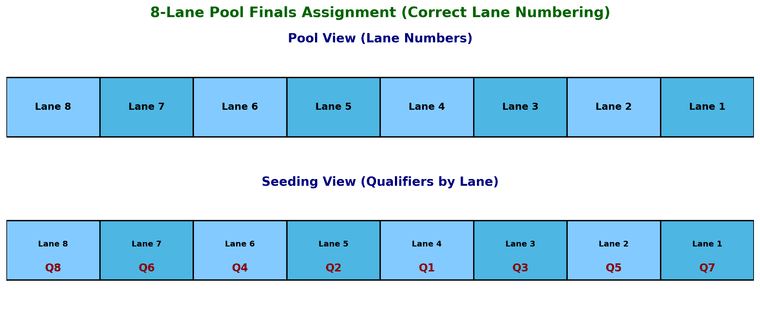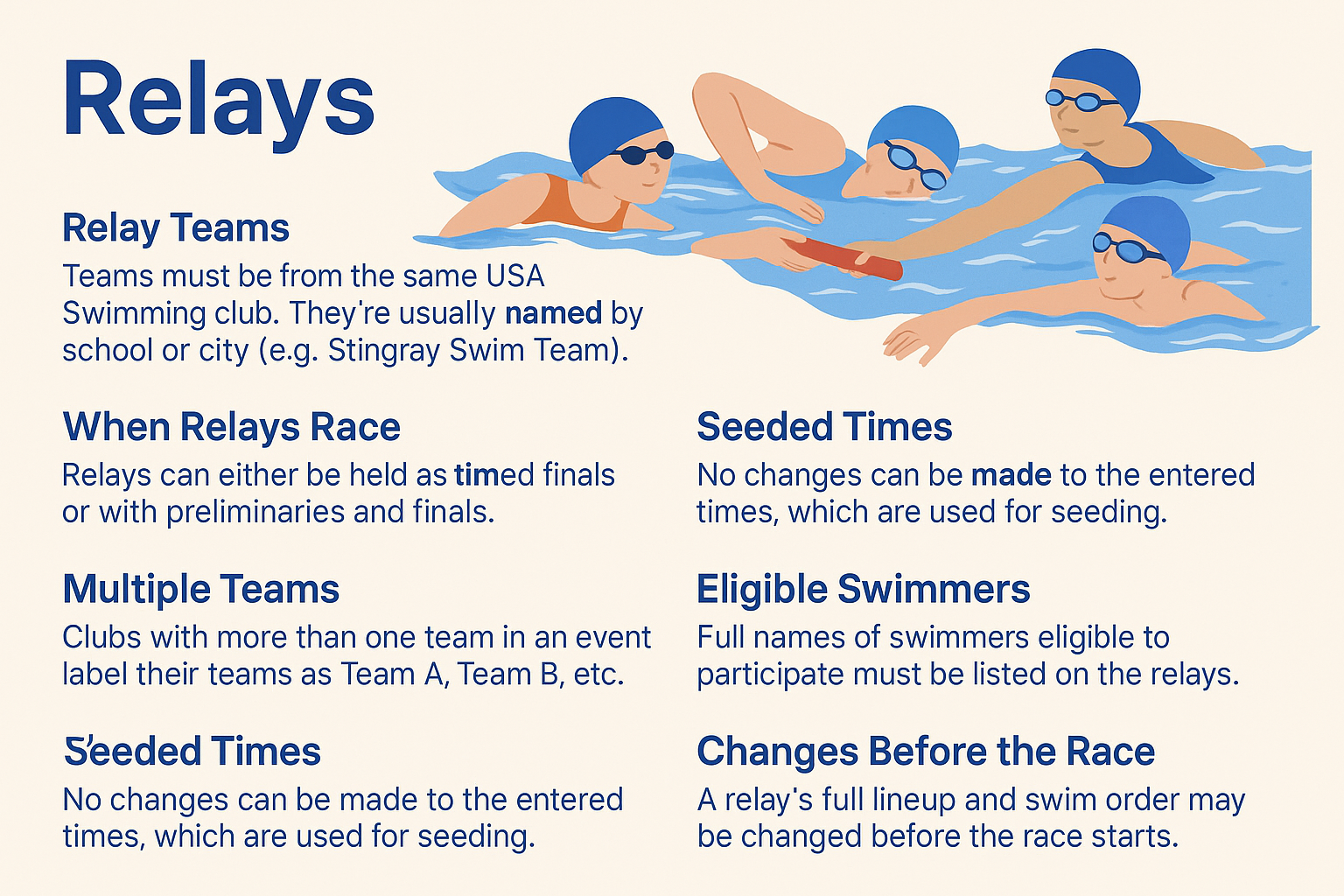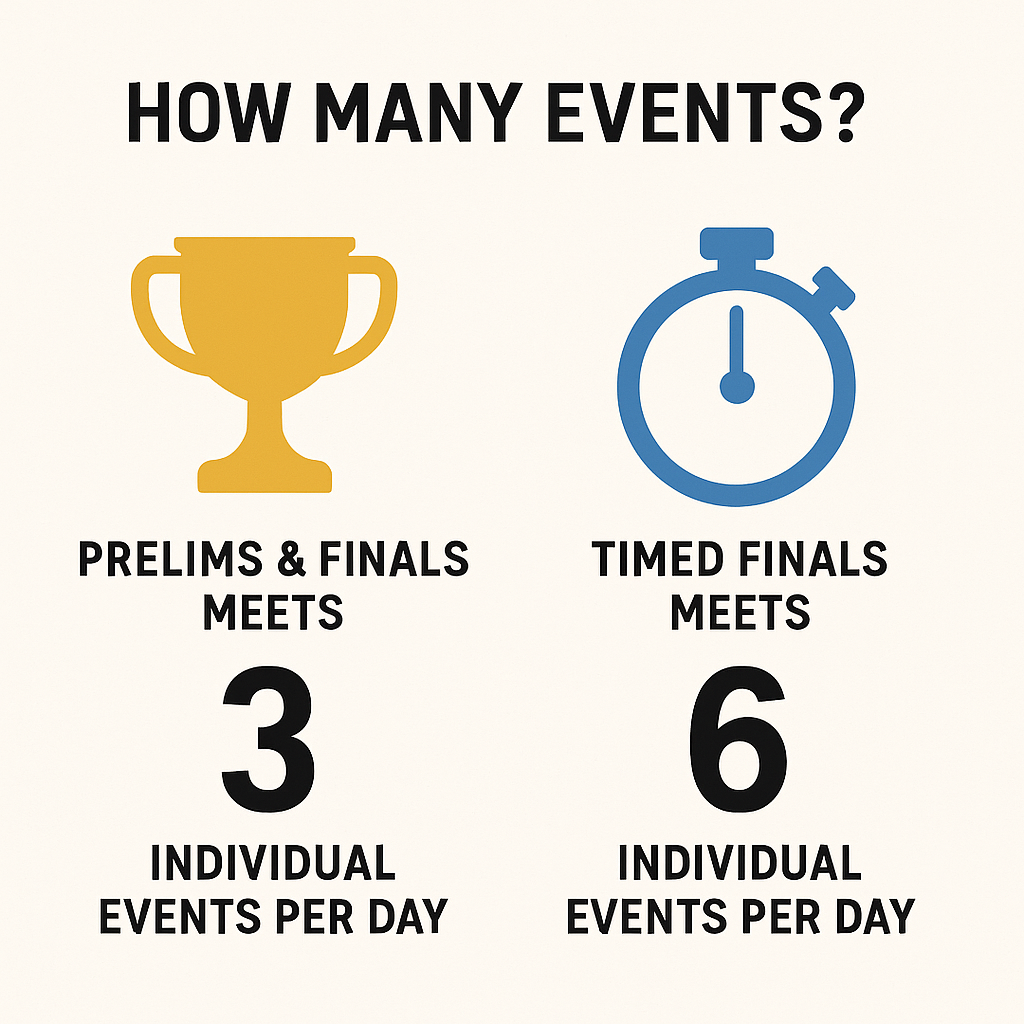FINA — now known as World Aquatics — assigns a performance point value to every eligible swim in Long Course Meters (LCM) or Short Course Meters (SCM) events.
These points provide a universal scoring system used worldwide to compare performances across strokes, distances, and genders — even when swimmers race different events or courses.
💡 In short:
FINA points measure how close a swim is to the world record for that event and course.
💡 What FINA Points Measure
Each swim earns a numeric score, typically between 1 and 1100 points:
| Points |
Meaning |
Color |
| 1000+ points |
Equal to or better than a current world record |
🖤 Black |
| 900–999 |
World-class international performance |
🔴 Red |
| 800–899 |
National elite level (comparable to USA “AAAA”) |
🔵 Blue |
| 600–799 |
Regional or high-level age-group performance |
🟡 Yellow |
| 400–599 |
Competitive developing swimmer |
🟢 Green |
| <400 |
Entry-level or early progress performances |
🤎 Brown |
The higher the score, the closer that swim is to the best-ever world performance for that gender and course.
⚙️ How FINA Points Are Calculated
FINA defines a base time for each event, gender, and course — usually the world record as of the current season.
That base time is worth 1000 points.
The scoring formula is:
FINA Points = 1000 × (Base Time ÷ Swimmer Time)³
So if a swimmer matches the base time exactly, they earn 1000 points.
A slower swim gets proportionally fewer points according to that cubic formula.
Example:
If the men’s 100 Free LCM base is 46.40 seconds and a swimmer does 49.00:
1000 × (46.40 ÷ 49.00)³ = 859 points
🧮 Example: Comparing Two Swims
| Event |
Course |
Time |
FINA Points |
| 100 Free (Men) |
LCM |
49.00 |
859 |
| 200 Free (Men) |
LCM |
1:48.00 |
845 |
| 100 Breast (Women) |
LCM |
1:07.00 |
815 |
| 100 Fly (Women) |
LCM |
1:00.00 |
773 |
A 49.00 100 Free and a 1:48.00 200 Free are almost identical in “quality” —
both roughly 84–85% as good as the current world record level.
That’s the power of the system: it normalizes swim quality across all events.
🏊♀️ Which Course Does FINA Use?
FINA (now World Aquatics) publishes two official scoring tables — one for Long Course Meters (LCM, 50 m) and one for Short Course Meters (SCM, 25 m).
Each defines a base time worth 1000 points for every event and gender, derived from the world record valid for that season.
🌍 From SCY to FINA — How Conversion Works
When a swim is recorded in Short Course Yards (SCY), Swim Standards first converts it to Long Course Meters (LCM) before calculating FINA points.
This ensures all results are measured on a consistent, world-comparable scale.
By default, Swim Standards uses a performance-based conversion model, derived from regression data and designed to reflect how swimmers’ times actually change between courses.
This approach accounts for pacing, turns, and stroke efficiency — not just a fixed multiplier.
You can also view results using Administrative (NCAA) or Classical (Stanback/Colorado) models, which apply traditional factor-based conversions.
Learn more in Administrative vs. Classical vs. Performance Swim Conversions — What’s the Difference?
🌍 Why SwimStandards Uses LCM by Default
Most world records, international competitions, and global rankings are based on LCM swims.
That’s why World Aquatics (formerly FINA) uses LCM points as the global standard for comparisons and world rankings.
| Reason |
Explanation |
| 🏅 Global baseline |
Olympic Games and World Championships are all raced in 50 m pools (LCM). |
| 📊 Ranking consistency |
Official World Aquatics Rankings use LCM points whenever available. |
| 📈 Historical continuity |
FINA’s original scoring system was derived from long-course world records. |
| 🌎 Global comparability |
LCM scoring provides a consistent scale across all countries and competitions. |
💠 When SCM Is Used Instead
Some events — notably the 100 Individual Medley (100 IM) — exist only in short-course pools.
For these SCM-only events, SwimStandards automatically converts SCY or LCM swims to SCM before applying the FINA scoring formula.
| Event |
Why SCM is used |
| 100 IM |
Defined only for SCM (no 50 m version exists). |
| World Cup / European short-course meets |
Officially scored with SCM FINA tables. |
✅ Summary
| Situation |
Course Used for FINA Points |
| Most events (50–1500 m, 200/400 IM) |
LCM |
| 100 IM or SCM-only events |
SCM |
| Comparing global performance |
LCM |
| Analyzing short-course technique |
SCM |
🧭 In short:
LCM = Global standard for world-level scoring
SCM = Specialty or short-course events (like 100 IM)
SwimStandards follows this convention so FINA points are accurate, comparable,
and aligned with official World Aquatics scoring methodology.
🔍 FINA vs. USA Power Points
| Feature |
FINA Points |
USA Power Points |
| Origin |
World Aquatics (formerly FINA) |
USA Swimming |
| Scope |
International |
U.S. domestic |
| Base Reference |
World records (LCM/SCM) |
Age-adjusted percentile tables |
| Courses Supported |
LCM & SCM |
SCY & LCM |
| Purpose |
Global performance comparison |
Age-group and national ranking |
| Typical Range |
1–1100 |
1–1300* |
| Use Case |
Compare to world-class |
Compare within age and country |
In short:
- 🏆 FINA Points = global performance measure
- 🇺🇸 Power Points = U.S. age-based comparison
Both appear on SwimStandards to show how a swim ranks locally and globally.
🧮 *How High Can Power Points Go?
While the USA Swimming Power Point tables technically extend up to 1300 points, scores above 1100 are extremely rare in real-world swimming.
Across the entire 2024–2025 Swim Standards database, only eight swims surpassed 1100 points.
One standout example comes from Ayden Tan, who delivered an exceptional 50.76 in the 100 Backstroke (Age 12) at the 2025 East Bay Silver Dolphins Short Course C/B/B+ Meet – earning 1146 Power Points, the highest recorded in the nation that season.
Performances like these sit far beyond the “AAAA” (~800 points) benchmark and underline how extraordinary it is for a young swimmer to break the 1100-point mark.
🧭 Why FINA Points Matter
FINA points let swimmers, coaches, and analysts:
- Compare performances across strokes and distances.
- Evaluate improvement across short-course and long-course seasons.
- Benchmark against world-class standards.
- Track progression toward elite international levels.
They serve as the universal “currency” of swimming performance — used in world rankings, meet scoring, and international qualification systems.
🕓 Related Reading



